The process of harmonizing a scale involves building chords on each degree (note) of the scale, using only notes from that scale.
This post will:
- Take us through the process of harmonizing the harmonic minor scale with seventh chords.
- Analyze the chords that result, along with the Roman numerals assigned to each chord.
- Show the relationship between the chords in a harmonized harmonic minor scale and the scale itself.
- Provide instruction on how that relationship relates to soloing on a guitar.
There are two methods we could use to accomplish this:
- We could add the note an interval of a third above the triads we built in the last post.
- We could use the harmonized natural minor scale as our starting point, and then alter the seventh scale degree in the chords that contain that note, as we did with the triads.
In the interest of consistency, we will use the second method.
Harmonized A Natural Minor Scale
An A natural minor scale — harmonized with seventh chords — is shown in fig.1.
Fig.1

Harmonized A Harmonic Minor Scale
The only difference between an A natural minor scale and an A harmonic minor scale is the raised seventh degree (G#) in the harmonic minor scale (fig.2).
Fig.2


So to construct a harmonized A harmonic minor scale from a harmonized A natural minor scale, we need to change all of the G’s in the harmonized natural minor scale to G#’s in the harmonized harmonic minor scale in the chords that contain that note.
A harmonized A harmonic minor scale is shown in fig.3.
Fig.3

Diatonic Chords: Seventh Chords
The raised seventh scale degree (G#) in an A harmonic minor scale is included in four of the chords in the harmonized scale.
Consequently, the qualities of those four chords change from what they were in a natural minor scale, where the flatted seventh scale degree was G natural:
- The i chord is minor, major seventh.
- The bIII chord is major seventh, sharp five.
- The V chord is dominant seventh.
- The vii° chord is diminished seventh (and the root note is a half step higher than it is in a harmonized natural minor scale).
The other three chords remain unchanged.
The imM7 Chord
The imM7 chord in a harmonized harmonic minor scale is minor, major seventh in quality.
The chord formula for a minor, major seventh chord is 1, b3, 5, 7.
A minor, major seventh chord contains the first, flatted third, fifth and seventh degrees of the major scale with the same root note.
An AmM7 chord contains the notes C, Eb, G and B — the first, flatted third, fifth and seventh notes in an A major scale (fig.4a).
The bIIImaj7+ Chord
The bIIImaj7+ chord in a harmonized harmonic minor scale is major seventh, sharp five in quality.
The chord formula for a major seventh, sharp five chord is 1, 3, #5, 7.
A major seventh, sharp five chord contains the first, third, sharped fifth and seventh degrees of the major scale with the same root note.
A Cmaj7+ chord contains the notes C, E, G# and B — the first, third, sharped fifth and seventh notes in a C major scale (fig.4b).
The V7 Chord
The V7 chord in a harmonized harmonic minor scale is dominant seventh in quality.
The chord formula for a dominant seventh chord is 1, 3, 5, b7.
A dominant seventh chord contains the first, third, fifth and flatted seventh degrees of the major scale with the same root note.
An E7 chord contains the notes E, G#, B and D — the first, third, fifth and flatted seventh notes in an E major scale (fig.4c).
The vii°7 Chord
The vii°7 chord in a harmonized harmonic minor scale is diminished seventh in quality (and the root note of the chord is a half step higher than it is in a harmonized natural minor scale).
The chord formula for a diminished seventh chord is 1, b3, b5 bb7.
A diminished seventh chord contains the first, flatted third, flatted fifth and double flatted seventh degrees of the major scale with the same root note.
A G#°7 chord contains the notes G#, B, D and F — the first, flatted third, flatted fifth and double flatted seventh notes in a G# major scale (fig.4d).
Fig.4

Roman Numerals
Every harmonic minor scale has seven seventh chords that are diatonic to it, one chord for each scale degree.
And each of the seven diatonic chords is assigned a Roman numeral, which reflects the chord’s position within the key, relative to the tonal center (the first note or chord).
The Roman numerals representing the seventh chords diatonic to an A harmonic minor scale are shown in fig.5.
Fig.5

Sequence of Chords
Every harmonized harmonic minor scale has the same sequence of seventh chords. As the sequence of chord qualities is the same in every key, the sequence of Roman numerals is also identical.
In any given harmonic minor scale:
- The imM7 chord is minor, major seventh.
- The ii7b5 chord is minor seventh, flat five.
- The bIIImaj7+ chord is major seventh, sharp five.
- The iv7 chord is minor seventh.
- The V7 chord is dominant seventh.
- The bVImaj7 chord is major seventh.
- The vii°7 chord is diminished seventh.
All 12 Harmonized Harmonic Minor Scales: Seventh Chords
All 12 harmonized harmonic minor scales are shown in fig.6.
Fig.6

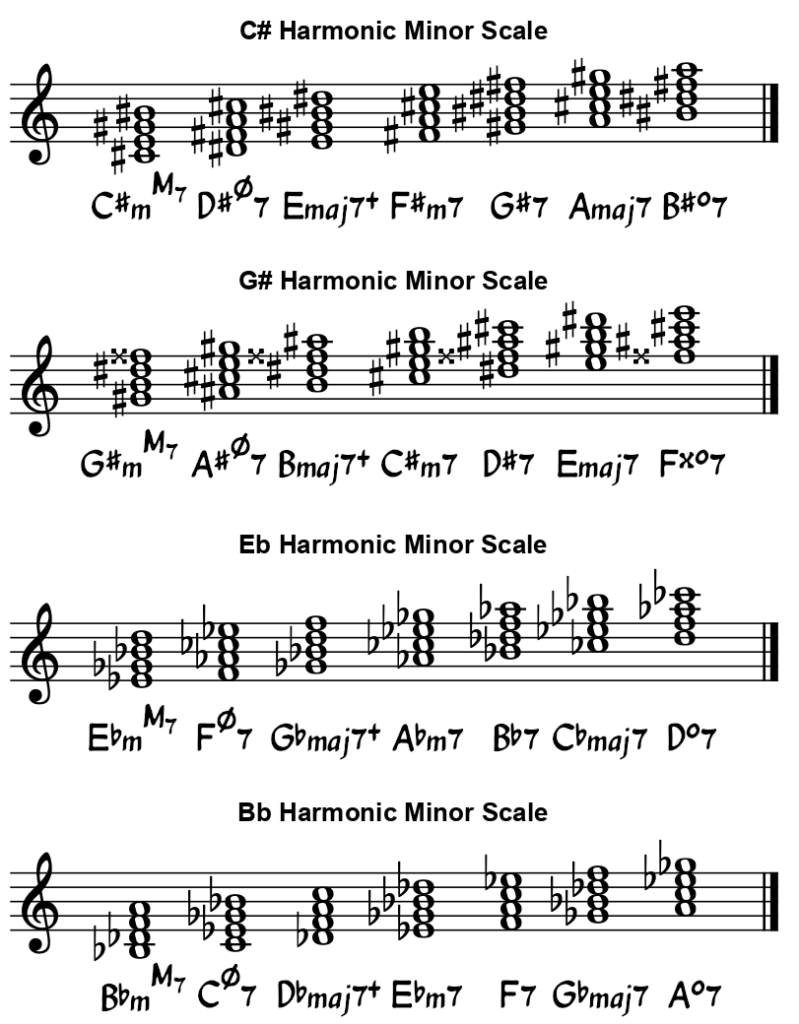
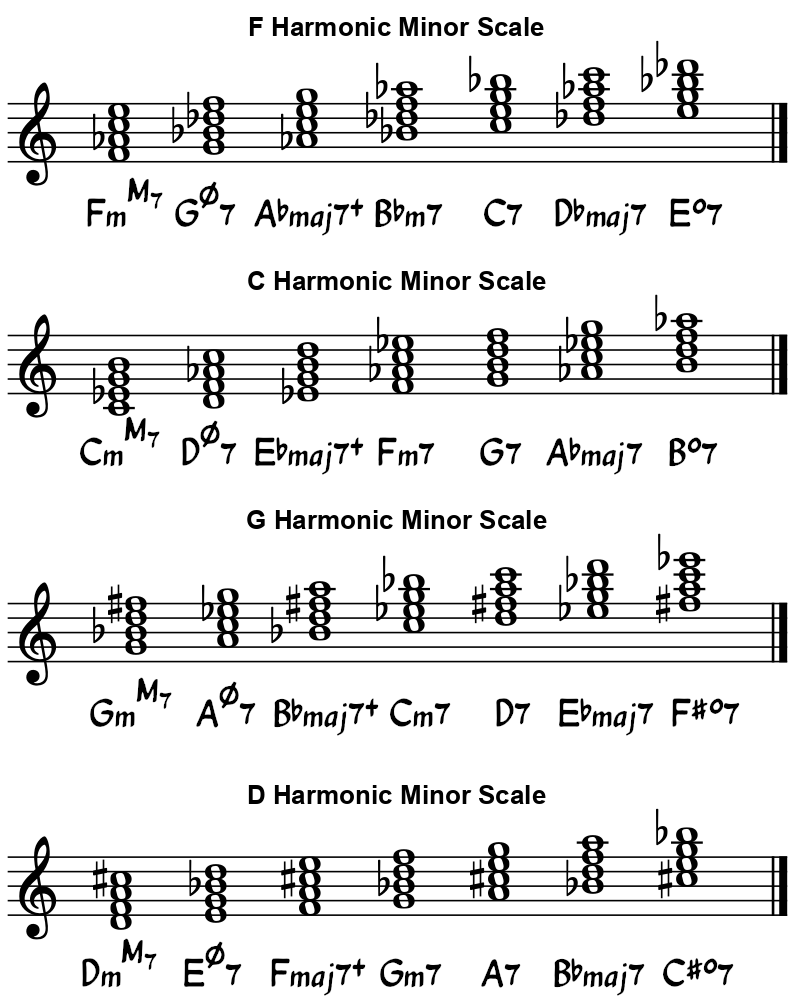
New Chords on a Guitar
There are three seventh chords in a harmonized harmonic minor scale that are new to this series. Common fingerings and examples are provided below.
Minor, Major Seventh Chord
Fig.7 shows a common fingering for a minor, major seventh chord.
Fig.7

This fingering will allow you to play a minor, major seventh chord with any root note:
- To play a CmM7, place the barre on the eighth fret (fig.8a).
- To play an AbmM7, place the barre on the fourth fret. (fig.8b).
Fig.8

Major Seventh, Sharp Five Chord
Fig.9 shows a common fingering for a major seventh, sharp five chord.
Fig.9
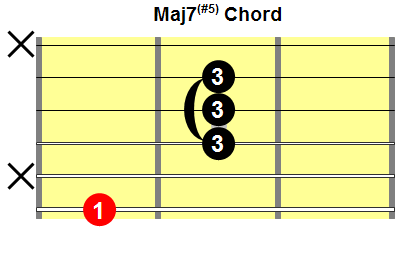
This fingering will allow you to play a major seventh, sharp five chord with any root note:
- To play a Cmaj7+, place your first finger on the sixth string, eighth fret (fig.10a).
- To play an Abmaj7+, place your first finger on the sixth string, fourth fret (fig.10b).
Fig.10

Diminished Seventh Chord
Fig.11 shows a common fingering for a diminished seventh chord.
Fig.11
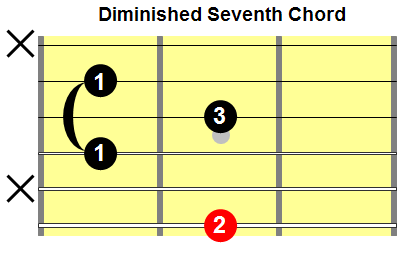
This fingering will allow you to play a diminished seventh chord with any root note:
- To play a C°7, place your second finger on the sixth string, eighth fret (fig.12a).
- To play an Ab°7, place your second finger on the sixth string, fourth fret (fig.12b).
Fig.12
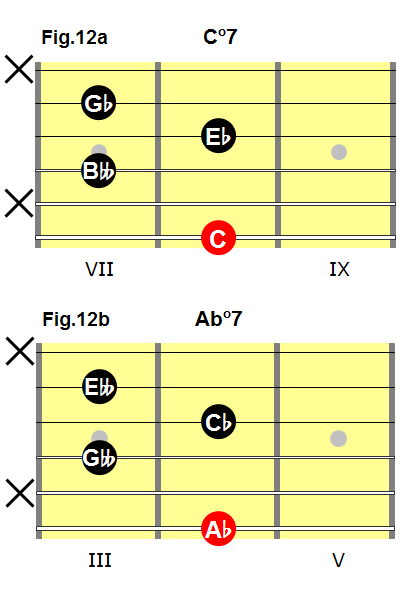
Soloing Application
In general, you can use a harmonic minor scale to solo over any of the chords that are diatonic to it. The notes generally won’t clash with the chords.
Related Posts
Related posts include:
